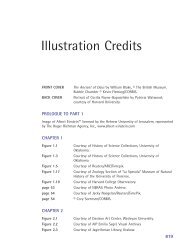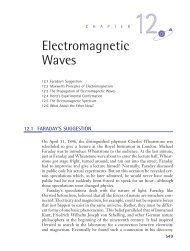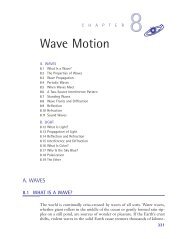Chapter 9: Einstein and Relativity Theory (319 KB) - D Cassidy Books
Chapter 9: Einstein and Relativity Theory (319 KB) - D Cassidy Books
Chapter 9: Einstein and Relativity Theory (319 KB) - D Cassidy Books
Create successful ePaper yourself
Turn your PDF publications into a flip-book with our unique Google optimized e-Paper software.
3637_<strong>Cassidy</strong>TX_09 6/14/02 12:08 PM Page 419<br />
9.5 SIMULTANEOUS EVENTS 419<br />
John<br />
C<br />
C<br />
A<br />
Jane<br />
B<br />
v<br />
FIGURE 9.8 <strong>Einstein</strong>’s thought experiment demonstrating the<br />
relativity of simultaneous events.<br />
bulbs. (Since this is a thought experiment, we may neglect his reaction time,<br />
or else he might use a switch activated electronically.)<br />
John <strong>and</strong> Jane try the experiment. The instant Jane reaches the midpoint<br />
position between A <strong>and</strong> B, the switch is closed, the light bulbs light up, <strong>and</strong><br />
John sees the flashes simultaneously. But Jane sees something different: to<br />
her the flashes do not occur simultaneously. In fact, the bulb at B appeared<br />
to light up before the bulb at A. Why Because she is traveling toward B<br />
<strong>and</strong> away from A <strong>and</strong>, because the speed of light is the same regardless of<br />
the motion of the observer, she will encounter the beam from B before the<br />
beam from A reaches her. Consequently, she will see the flash at B before<br />
she sees the flash at A. The conclusion: The two events that John perceives<br />
to occur simultaneously do not occur simultaneously for Jane. The reasons<br />
for this discrepancy are that the speed of light is the same for both observers<br />
<strong>and</strong> that each observer is moving in a different way relative to the<br />
events in question.<br />
It might be argued that Jane could make a calculation in which she computed<br />
her speed <strong>and</strong> the speed of light, <strong>and</strong> then very simply find out if the<br />
flashes actually occurred as she saw them or as John claimed to see them.<br />
However, if she does this, then she is accepting a specific frame of reference:<br />
That is, she is assuming that she is the moving observer <strong>and</strong> that John<br />
is the stationary observer. But according to the relativity postulate motions<br />
are relative, <strong>and</strong> she need not assume that she is moving since there is no<br />
preferred frame of reference. Therefore she could just as well be the stationary<br />
observer, <strong>and</strong> John, st<strong>and</strong>ing next to the track, could be the moving<br />
observer! If that is so, then Jane could claim that the flash at B actually<br />
did occur before the flash at A <strong>and</strong> that John perceived them to occur<br />
simultaneously only because from her point of view he was moving toward






